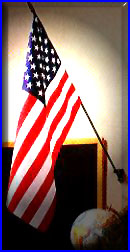
Herold Aloysius Harveson |
USS Utah |

Site Dedication (Click on Flag to link to the USS Utah Site Dedication) |
USS HARVESON DE-316 Displacement: 1,200 t. Length: 306' Beam: 36'7" Draft: 8'7" Speed: 21 k. Complement: 186 Armament: 3 3"; 2 40mm; 8 20mm; 3 21" torpedo tubes; 2 depth charge tracks; 8 hedge charge projectors; 1 hedge hog Class: EDSALL HARVESON (DE-316) was laid down by Consolidated Steel Corp., Orange, Tex., 9 March 1943; launched 22 May 1943; sponsored by Mrs. T. L. Herlong, mother; and commissioned at Orange, 12 October 1943, Lt. Comdr. P. L. Stinson, USCG, in command. Manned entirely by a Coast Guard crew, HARVESON completed shakedown out of Bermuda only to be seriously damaged in collision with a merchantman 15 December 1943, on a foggy night off the Virginia Capes. Repairs were completed at Portsmouth, Va., by February 1944, and the destroyer-escort joined Escort Division 22. Departing New York 1 March, HARVESON escorted a convoy to Londonderry, Ireland, via Halifax. In the next 14 months she escorted nine more convoys carrying vitally needed supplies for the European theater safely across the dangerous North Atlantic. When V-E Day came, CortDiv 22 was ordered to the Pacific; and HARVESON reached Pearl Harbor via the Panama Canal and San Diego 11 July to begin refresher training. HARVESON was still engaged in tactical training at Pearl Harbor when Japan capitulated, but soon she participated in the occupation of the defeated enemy's homeland. Departing Pearl Harbor 3 September, she escorted a convoy of LSTs to Japan, where she arrived Sasebo 24 September. During the next few weeks, she operated along the coast of Honshu, escorting amphibious force flagship MOUNT McKINLEY (AGC-7) and supporting occupation landings at Wakayama, Hiro, and Nagoya. She departed Yokohama for the United States 4 November and arrived Jacksonville, Fla., in December for duty with the Atlantic Fleet. She decommissioned at Green Cove Springs, Fla., 9 May 1947, and entered the Atlantic Reserve Fleet. HARVESON was towed to the Mare Island Navy Yard in 1950 for conversion to a radar picket ship. She recommissioned at Vallejo, Calif., 12 February 1951, Lt. Comdr. W. S. Slocum III in command; and, as the first of a new class of radar picket ships, she was redesignated DER-316. After intensive tests and vigorous tactical training, HARVESON joined Escort Squadron 10 at Newport, R.I., 30 May to begin duty as a radar picket ship. While on patrol, the former destroyer escort outfitted with the most modern radar and early detection warning devices, cruised off the coast of the United States to provide adequate early warning of any enemy attack. From her usual station in the North Atlantic, HARVESON also sailed to the Caribbean for frequent antisubmarine and tactical exercises. Departing Newport 15 July 1957, HARVESON reported for radar picket duty at Pearl Harbor 18 August. There she joined the Barrier Forces, Pacific Fleet, to strengthen America's warning system in the vast and lonely reaches of the Pacific. After almost 3 years of barrier patrols out of Hawaii, HARVESON steamed to San Francisco for inactivation. She decommissioned 30 June 1960 and joined the Pacific Reserve Fleet, Stockton, Calif. Her name was struck from the Navy List 1 December 1966. She was scheduled to be used as a target. HARVESON was sunk as a target off southern California on 10 October 1967. |
Herold Aloysius Harveson, born 7 August 1913 at Lake Charles, La., graduated from the U.S. Naval Academy 3 June 1937. After serving in Louisville and on the staff of the Pacific Fleet Scouting Force, Lt. (j.g.) Harveson was assigned to Utah 19 August 1941. Operating out of Pearl Harbor, the aged ax-battleship, converted to a target ship, served the fleet as the major antiaircraft training ship, as well as a key to developing carrier air-to-ship attack tactics. During the sneak attack on Pearl Harbor 7 December 1941, the Japanese launched two aerial torpedoes at the USS Utah (AG16). Both torpedoes struck the port side of the Utah. She had overturned and sunk by 0812. Like so many of her crew, Lt. Harveson gave his life in the opening moments of the war and was awarded the Navy Cross posthumously. [Ed. note: The above info was collected from various sources. In the interest of historical accuracy the following info was received from Daniel Herlong, Capt. USN (Ret.), brother of LT(jg) Harveson: "This is from my memory, and I know I never had all the details, but: I know that Herold's first ship was the LOUISVILLE. I did not know of his having staff duty, but he did spend some time in USS CHICAGO before receiving orders to USS UTAH. Capt. Herlong further states "---, that Herold was recommended for the Navy Cross, but I know that the reward he received was the Purple Heart." Regarding the correct spelling of LT(JG) Harveson's name, Capt. Herlong stated: "Herold Aloysius Harveson is the correct spelling according to Navy records and LA National Guard record, in which he served as a corporal before entering the Navy, as well as civil documents and family records. " |

